6 July 2006, Eugénie les Bains
Saturday, we left Pau and followed the Gave de Pau to Orthez, then turned north to Eugénie les Bains via Hagetmau. We saw a few vines along the way, but mostly corn and cattle. Although some restaurants had "flowerbeds" of them, and you could buy little plants in pots, we saw nary a field of "piments d'Espelette" on the hoof, as it were. I don't know where they actually grow them. Same thing with the ducks. This area produces, consumes, and exports one heck of a lot of ducks and duck products, but we only saw a couple of structures that could have been duck barns. I guess if we wanted to see actual ducks, we should have turned down one of the innumerable country lanes that left the roads we followed, each one sporting its little "foie gras" sign and arrow off into the hinterlands. Jurançon is famous for its wines, of course (David was delighted to find that they make dry whites as well as the sweet ones they're best known for; he liked them alot), but we'd already been warned by the sommelier at the Rosewood that the grapes were all out of sight of the town, behind the hills, between Pau and the Pyrenees.
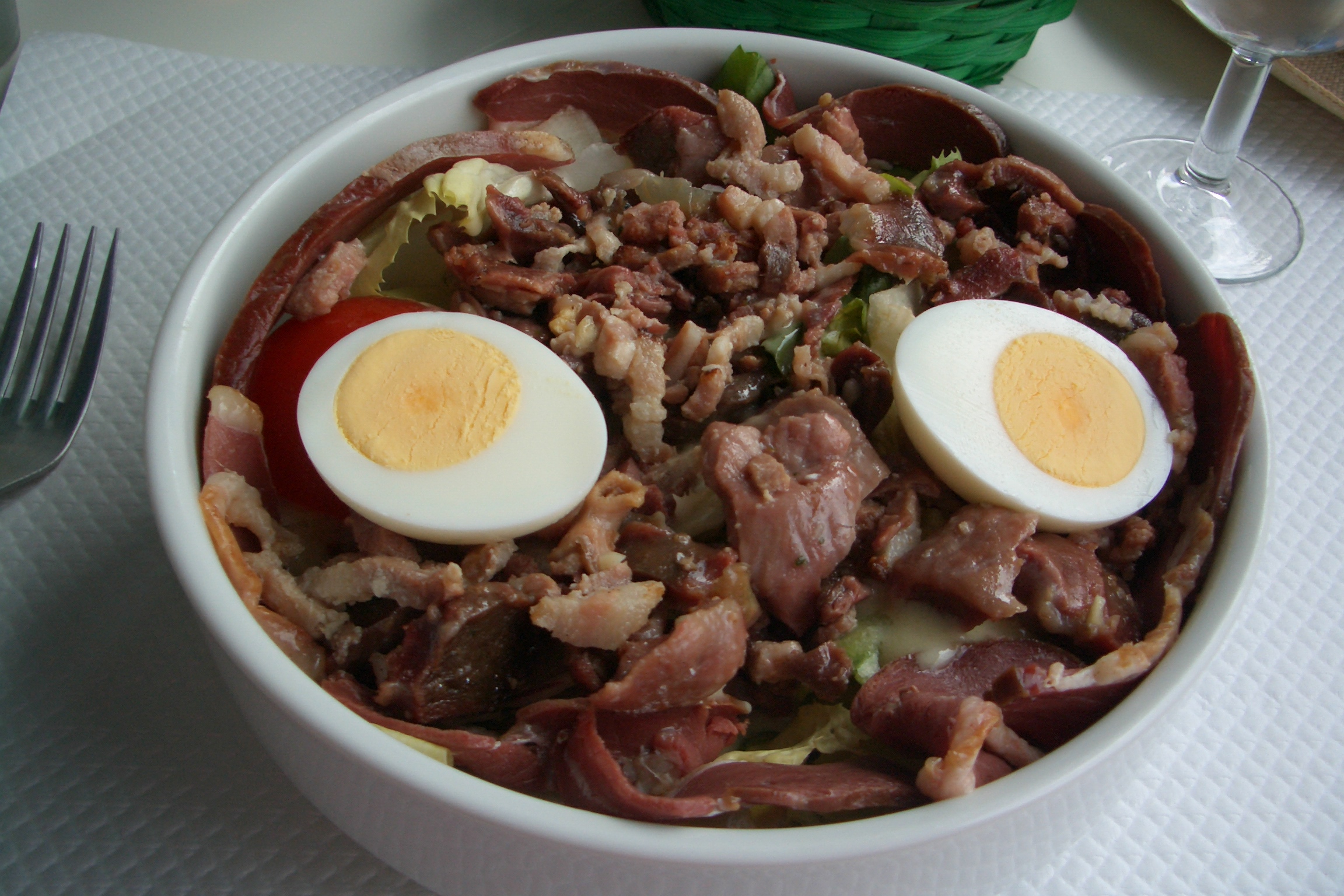 We stopped for lunch in Hagetmau (which apparently means "in the middle of a beech forest" in Gascon) at the Chat Botté pizzaria (a regional chain), which served excellent salads both to us and to the tattooed, leather-jacketed, gold-earringed biker guys at the next table (this area seems to be a major center for "tuning," which seems to be what we might call "customizing"; posters were up for a major tuning meet, advertising various vintage cars, customized motorcyclies, etc.). Note the perfectly boiled egg in the photo of my "salade Landaise"—no trace of gray-green around the yolk, slight darker spot in the center. I'd been rather surprised to get greeny-gray overboiled eggs a few places on this trip—in France, one expects better. Honest, there was salad under all those lardons, magret slices, eggs, and gizzards; the bowl was quite deep.
We stopped for lunch in Hagetmau (which apparently means "in the middle of a beech forest" in Gascon) at the Chat Botté pizzaria (a regional chain), which served excellent salads both to us and to the tattooed, leather-jacketed, gold-earringed biker guys at the next table (this area seems to be a major center for "tuning," which seems to be what we might call "customizing"; posters were up for a major tuning meet, advertising various vintage cars, customized motorcyclies, etc.). Note the perfectly boiled egg in the photo of my "salade Landaise"—no trace of gray-green around the yolk, slight darker spot in the center. I'd been rather surprised to get greeny-gray overboiled eggs a few places on this trip—in France, one expects better. Honest, there was salad under all those lardons, magret slices, eggs, and gizzards; the bowl was quite deep.
Eugénie les Bains is "Le 1re village minceur de la France" (France's premiere weight-loss village), according to the large signs at each end of its four-block main street. Two famous mineral springs, one hot and one cold, surface there and have long had the reputation for curative powers appropriate to rheumatism and digestive and metabolic problems. The town was formed de novo in the mid-19th century, especially to serve as a welcome center for visitors to the springs. The process required lengthy negiations, especially with the township that gave up "possession" of the actual hot spring, but were finally completed, and the organizers (dare I say "developers"?) successfully petitioned the Empress Eugénie for permission to name it after her. Its popularity has only grown, especially since the owners' successful spin on overweight as a "metabolic problem."
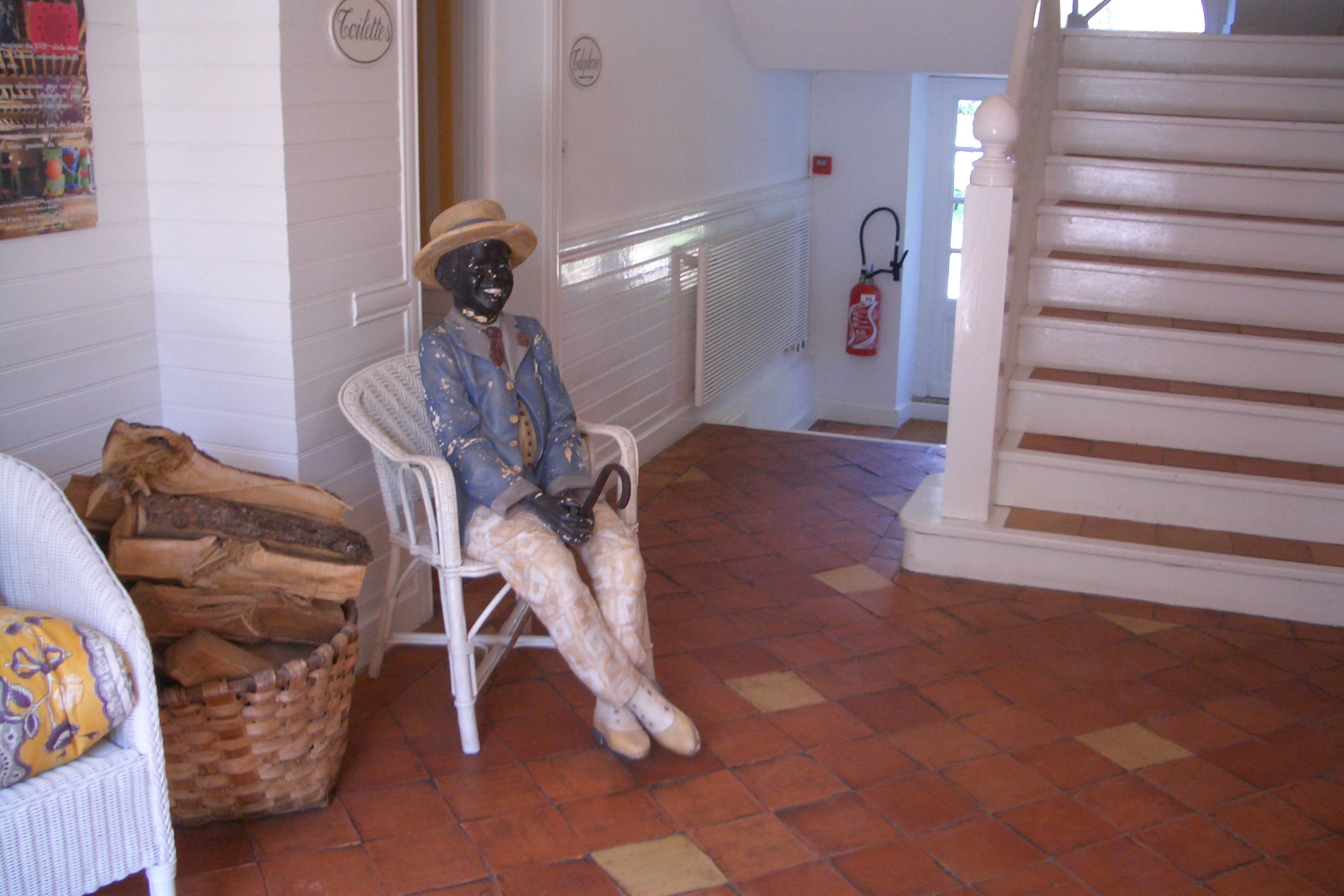 Today, about half the village, including at least one of the springs (if not both), is owned by multi-starred celebrity chef Michel Guérard, and his complex of hotels, restaurants, and spas employs 350 people, about half the permanent population. We stayed at La Maison Rose, the less expensive of the two hotels (actually rather spartan), but reserved at both restaurants, the G-M 19/20 Prés d'Eugéie and the 15/20 Auberge de la Ferme aux Grives. The lobby of La Maison Rose features this rather startling life-size figure, which must make every American guest wince every day.
Today, about half the village, including at least one of the springs (if not both), is owned by multi-starred celebrity chef Michel Guérard, and his complex of hotels, restaurants, and spas employs 350 people, about half the permanent population. We stayed at La Maison Rose, the less expensive of the two hotels (actually rather spartan), but reserved at both restaurants, the G-M 19/20 Prés d'Eugéie and the 15/20 Auberge de la Ferme aux Grives. The lobby of La Maison Rose features this rather startling life-size figure, which must make every American guest wince every day.
The breakfast room of our hotel is also the dining room for those who are here undergoing a weight-loss regimen. Their daily menu is posted; all very gourmet, but only 400-600 calories per person per meal. They also get served a different breakfast. Instead of bowls of apples on the coffee tables, they have bowls of grapefruit. Our room is provided with three lemons, artfully arranged on the desk. I hope we're not expected to know what to do with them, as I plan to regard them strictly as art. The whole complex has an elaborate system of assignments. We're in room 43, so we have to sit at table 43, park in space 43, etc. (parking space 43 stays put, but table 43 moves around). If we sit at the wrong table, we could be served the diet breakfast! Large pitchers of iced "slimming tea" are always available on the sideboard. I think the dieters are supposed to drink a certain amount of it each day. Since they won't tell you what's in it (just "five herbs") I didn't try it.
The place also does several things "backwards." For example, most places provide a buffet of breakfast foods, and a waitress asks what hot drink she should bring you. Here, there's a buffet of hot drinks (coffee, tea, chocolate), and the waitress brings you an individual tray of everything else (bread, croissants, yogurt, jam, butter, half a grapefruit or some strawberries, ham, cheese, OJ). Most places, when you press the handle on the toilet, it flushes immediately, then refills its tank. Here, when you press the handle, it starts filling the tank, then abruptly flushes 2 or 3 minutes later, with a great groaning and banging of pipes. Odd.
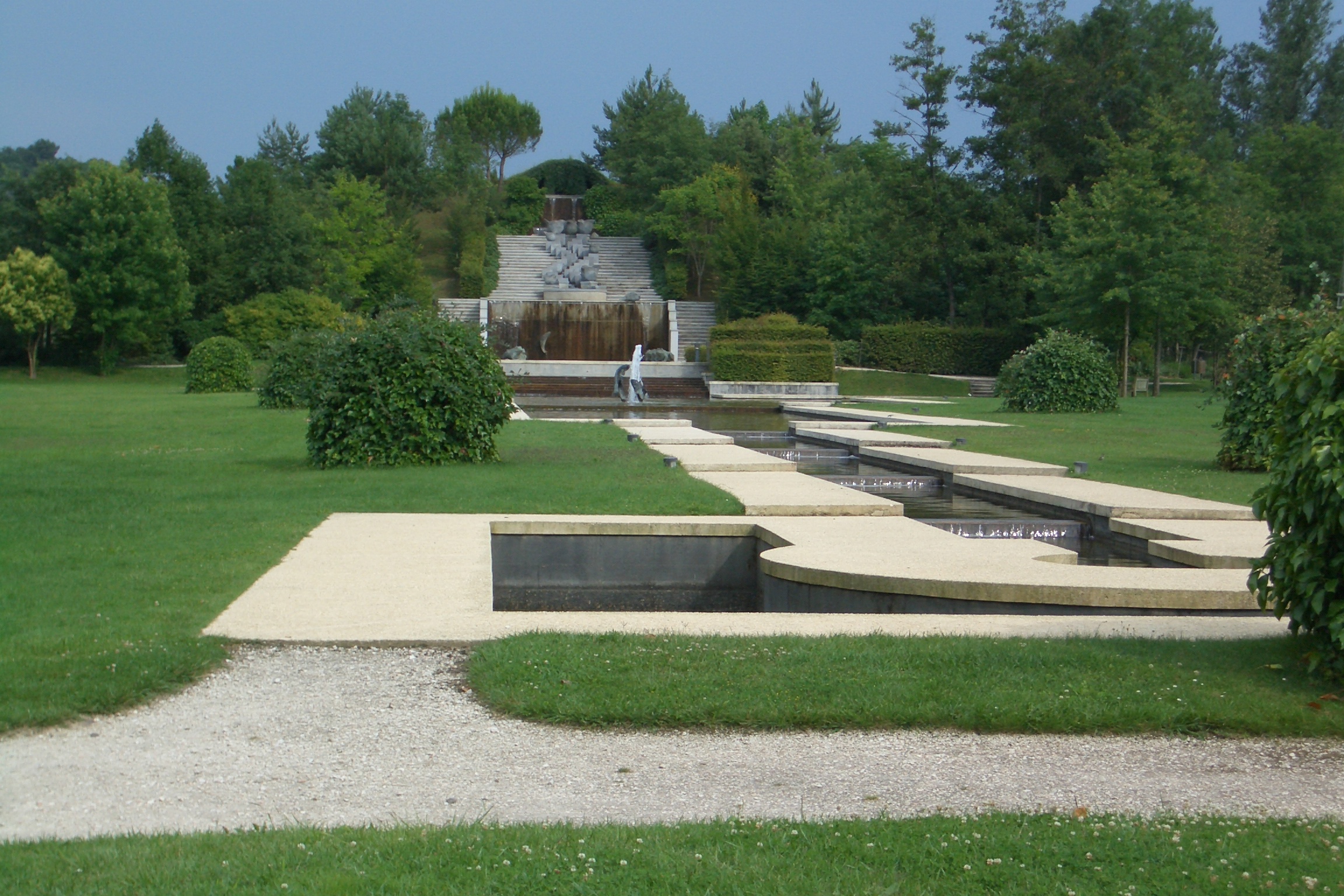
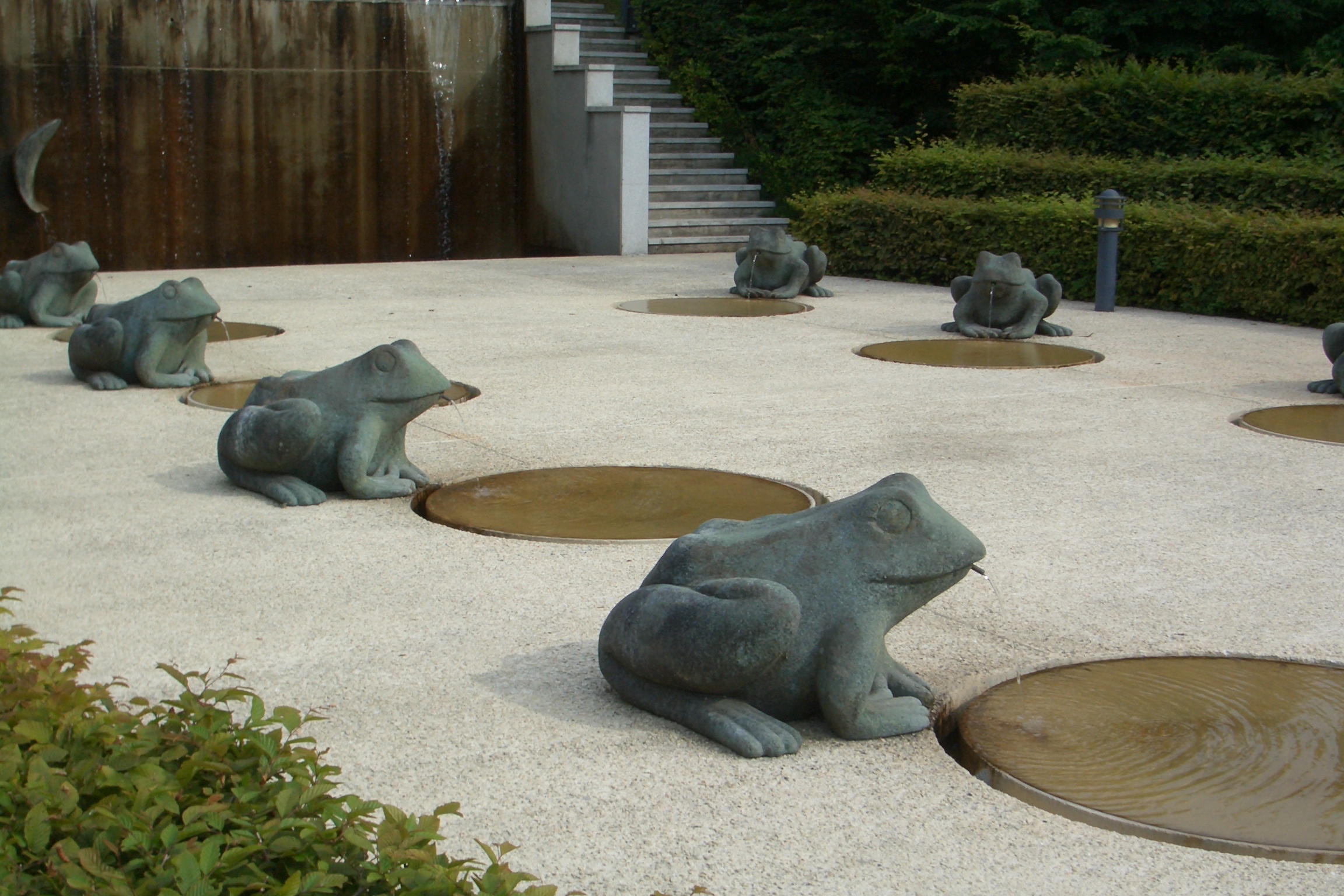 Across the main street from our hotel is a lovely park crossed by the Bahus River, which feeds a long series of cascades and fountains with stylized bronze trout, frogs, birds, and (for some reason) penguins. The frogs, each the size of a collie, are fountains. Locals were playing pétanque on one of the broad gravel paths. A large cutaway model demonstrated the workings of a grist-mill powered by a horizontal water wheel, of which several apparently used to line the Bahus.
Across the main street from our hotel is a lovely park crossed by the Bahus River, which feeds a long series of cascades and fountains with stylized bronze trout, frogs, birds, and (for some reason) penguins. The frogs, each the size of a collie, are fountains. Locals were playing pétanque on one of the broad gravel paths. A large cutaway model demonstrated the workings of a grist-mill powered by a horizontal water wheel, of which several apparently used to line the Bahus.
 The park's most astonishing feature, though, was the local bull ring! It was empty and standing open, so we went in and walked around in the arena; it seemed to seat 300 or so. Each town around here seems to have one, and "corridas" and "courses Landaises" were scheduled one place or another most evenings. We never managed to be in the right place at the right time (they tended to conflict with our dinner reservations), but from what we gather from posters, these are nonlethal, bloodless bullfights; the bulls have blunt caps on their horns, and the bullfighters are unarmed. This ring had stalls for perhaps eight bulls at one end, each with a name chalked on the door, though we couldn't tell whether they were the names of individual animals or of, say, the breeders who supplied them.
The park's most astonishing feature, though, was the local bull ring! It was empty and standing open, so we went in and walked around in the arena; it seemed to seat 300 or so. Each town around here seems to have one, and "corridas" and "courses Landaises" were scheduled one place or another most evenings. We never managed to be in the right place at the right time (they tended to conflict with our dinner reservations), but from what we gather from posters, these are nonlethal, bloodless bullfights; the bulls have blunt caps on their horns, and the bullfighters are unarmed. This ring had stalls for perhaps eight bulls at one end, each with a name chalked on the door, though we couldn't tell whether they were the names of individual animals or of, say, the breeders who supplied them.
We had dinner at Les Prés d'Eugéie, Michel Guérard's top restaurant, a G-M 19/20 (there are only 12 in the world at that rank; this was our second, plus one that became a 19 after we ate there while it was an 18), and we're here to tell you—the man can cook! I didn't actually expect him to be there; he's so well known that I supposed he had establishments elsewhere and would probably be in Hong Kong or Las Vegas this week, but no, the staff assure us that, although he travels for vacations and speaking engagements, he spents almost all his time in the kitchens at Eugénie, supervising, trouble-shooting, expediting, and often cooking. In fact, during our dinner, he twice came out of the kitchen, in soiled chef's whites, to check the soccer score on the big TV in the adjacent lounge (and to wish us "bon appetit" in passing). France played (and beat) Brazil in the World Cup quarter finals that night, and the maitre d' would periodically stroll through the room, repeating softly "still 1 to 0" for the convenience of those who cared. (We watched the end of the game back in our room, and the sportsmanship was magnificent. Both teams fought like demons right up to the final whistle, then fell on each other's necks in exhaustion, swapping jerseys, shaking hands, and hugging.) The Tour de France started today in Strasbourg, but nobody's paying any attention until the World Cup is over.
Dinner was great.
Amuse-bouche: Miniature skewers of grilled liver and kidney, balanced on cups of intense cream of mushroom soup. Two miniature croissants, each with a bit of anchovy inside; two hot cheese puffs with bacon on top, and slices of house-made dry sausage.
First course, David: Spider crab in a cold grapefruit aspic with curry whipped cream.
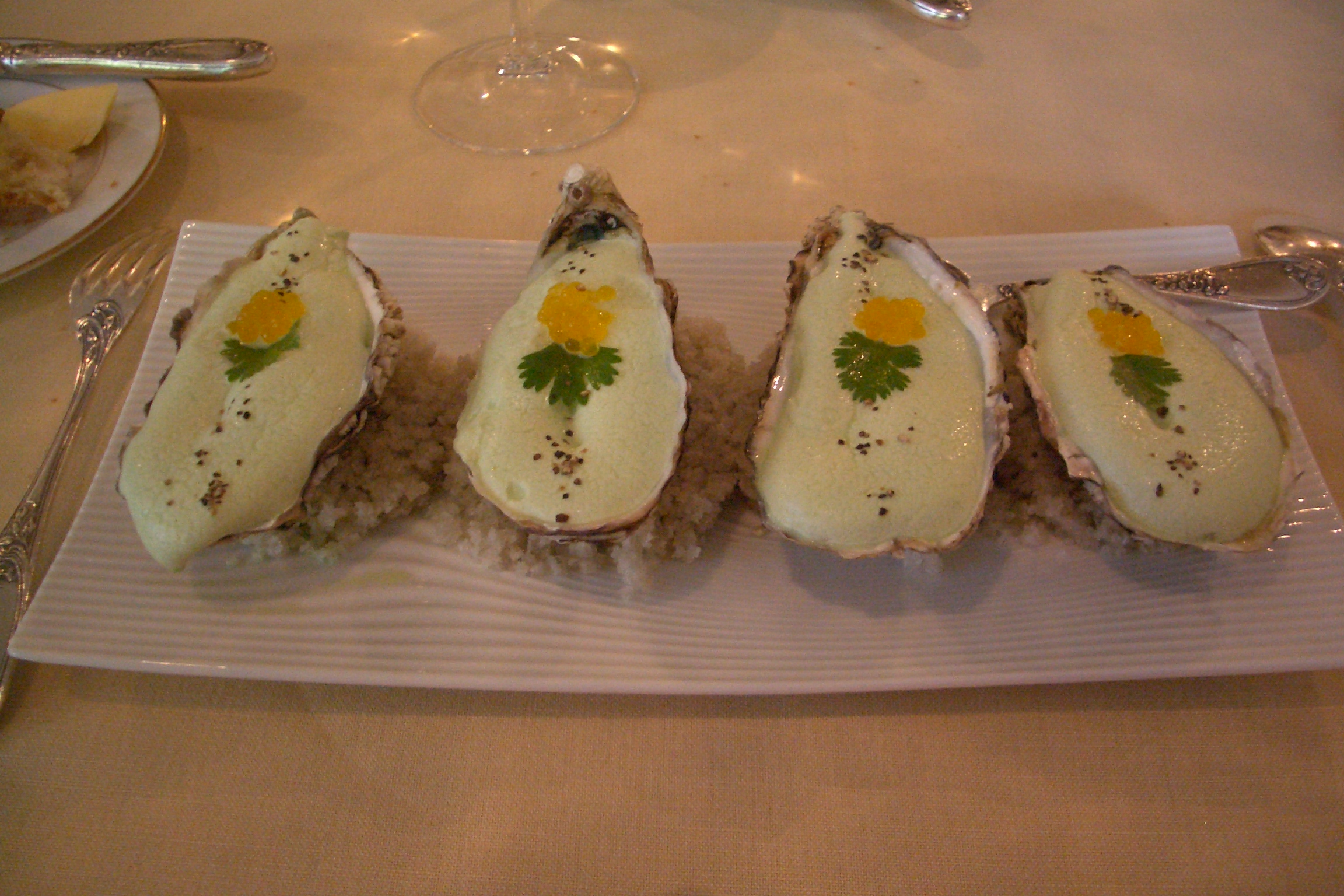 First course, Anne: Oysters. In each very deep oyster shell, the chef layered, from the bottom up, a bit of sour lemon jelly, a raw oyster and its juices, a bit of fresh ginger, a whipped-cream mousse of green (i.e., unroasted) coffee run under the broiler for a moment, a cilantro leaf, and a dab of what looked like caviar but had the texture of soft jelly beans. Yum!
First course, Anne: Oysters. In each very deep oyster shell, the chef layered, from the bottom up, a bit of sour lemon jelly, a raw oyster and its juices, a bit of fresh ginger, a whipped-cream mousse of green (i.e., unroasted) coffee run under the broiler for a moment, a cilantro leaf, and a dab of what looked like caviar but had the texture of soft jelly beans. Yum!
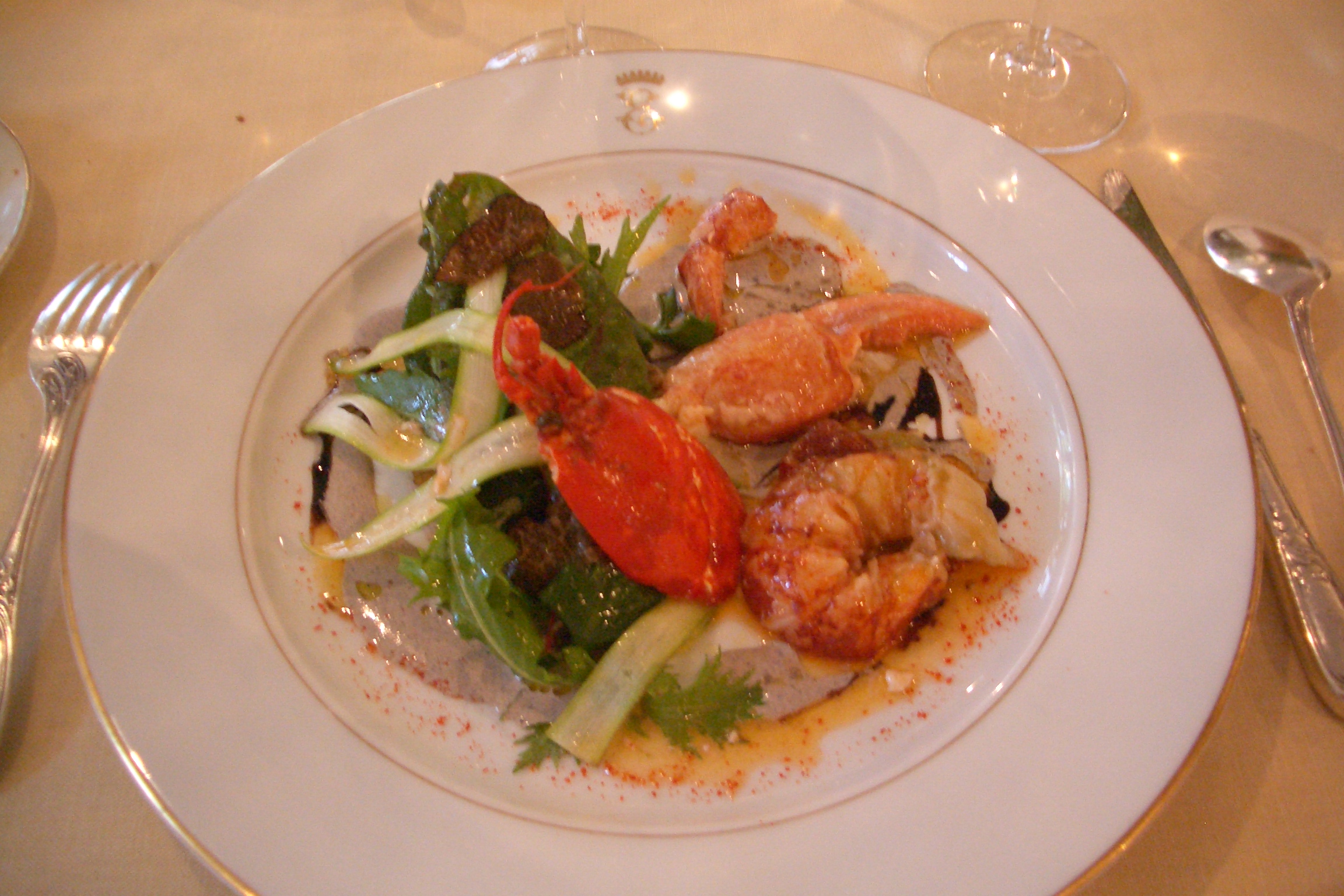 Second course, both: Warm salad of lobster sautéed in salted butter with a peppery artichoke sauce, lengthwise ribbons of shaved asparagus, and truffles.
Second course, both: Warm salad of lobster sautéed in salted butter with a peppery artichoke sauce, lengthwise ribbons of shaved asparagus, and truffles.
Third course, David: Fresh cod roasted with oysters on top, all on top of a disk of delicious "potato pie" that had something crisp mixed in (water chestnuts, we think). Garnished with herbs, caviar, and tiny home-made purple potato chips.
Third course, Anne: "Griblette" of bar (sea bass) in a sauce of Brussels sprouts and the famous pink onions of Brittany. Garnished with whole Brussels sprout leaves, herbs, and crisply fried slices of the pink onions.
Dessert, David: A whole white peach, peeled, poached, then dusted with sugar and broiled, set in a raspberry sauce, accompanied by outstanding lemon-verbena ice cream.
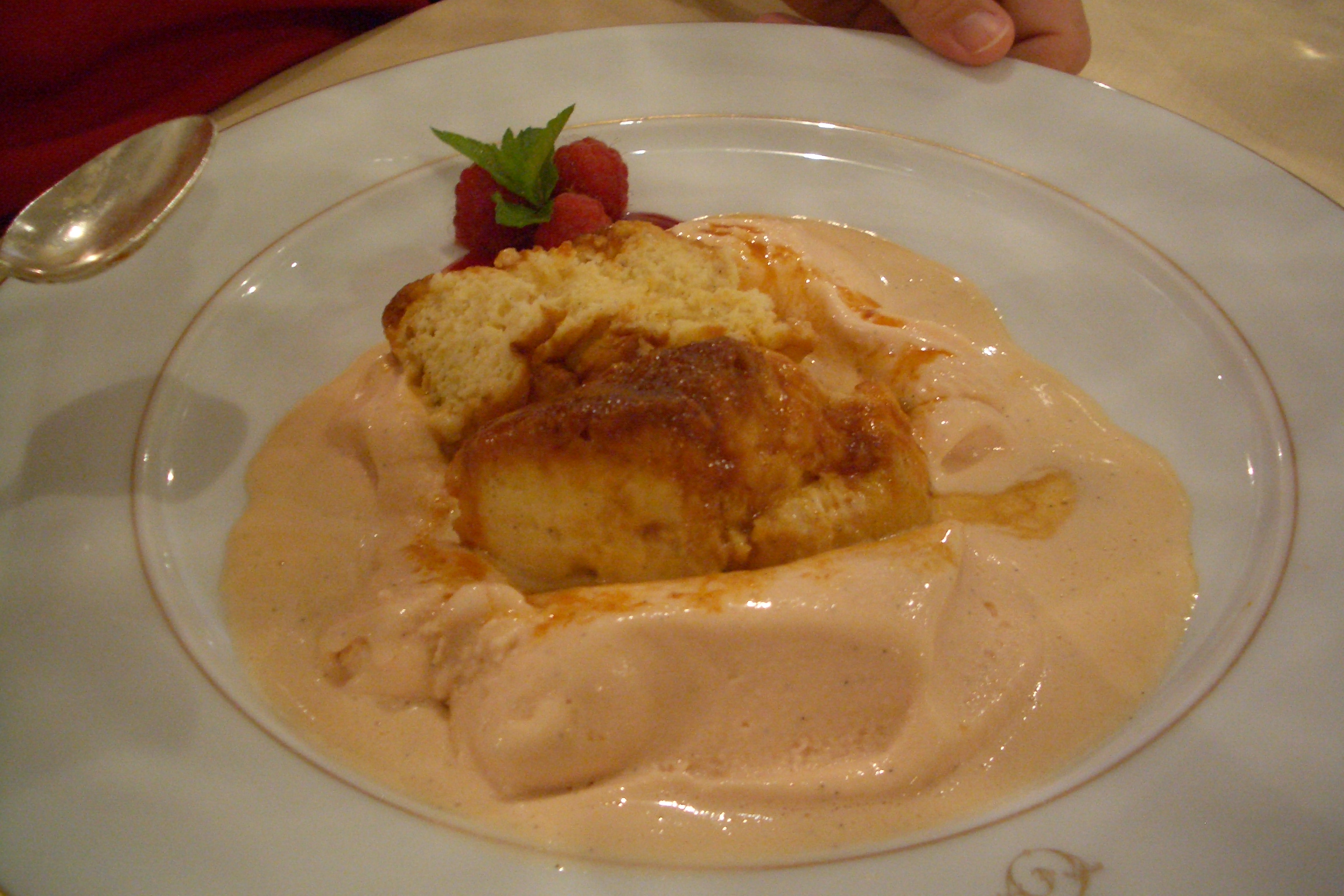 Dessert, Anne: "Le gâteau mollet du Marquis de Béchamel," a sort of cross between a caramel flan and a soft cake, surrounded by soft rhubarb ice cream.
Dessert, Anne: "Le gâteau mollet du Marquis de Béchamel," a sort of cross between a caramel flan and a soft cake, surrounded by soft rhubarb ice cream.
previous entry List of Entries next entry
 We stopped for lunch in Hagetmau (which apparently means "in the middle of a beech forest" in Gascon) at the Chat Botté pizzaria (a regional chain), which served excellent salads both to us and to the tattooed, leather-jacketed, gold-earringed biker guys at the next table (this area seems to be a major center for "tuning," which seems to be what we might call "customizing"; posters were up for a major tuning meet, advertising various vintage cars, customized motorcyclies, etc.). Note the perfectly boiled egg in the photo of my "salade Landaise"—no trace of gray-green around the yolk, slight darker spot in the center. I'd been rather surprised to get greeny-gray overboiled eggs a few places on this trip—in France, one expects better. Honest, there was salad under all those lardons, magret slices, eggs, and gizzards; the bowl was quite deep.
We stopped for lunch in Hagetmau (which apparently means "in the middle of a beech forest" in Gascon) at the Chat Botté pizzaria (a regional chain), which served excellent salads both to us and to the tattooed, leather-jacketed, gold-earringed biker guys at the next table (this area seems to be a major center for "tuning," which seems to be what we might call "customizing"; posters were up for a major tuning meet, advertising various vintage cars, customized motorcyclies, etc.). Note the perfectly boiled egg in the photo of my "salade Landaise"—no trace of gray-green around the yolk, slight darker spot in the center. I'd been rather surprised to get greeny-gray overboiled eggs a few places on this trip—in France, one expects better. Honest, there was salad under all those lardons, magret slices, eggs, and gizzards; the bowl was quite deep. Today, about half the village, including at least one of the springs (if not both), is owned by multi-starred celebrity chef Michel Guérard, and his complex of hotels, restaurants, and spas employs 350 people, about half the permanent population. We stayed at La Maison Rose, the less expensive of the two hotels (actually rather spartan), but reserved at both restaurants, the G-M 19/20 Prés d'Eugéie and the 15/20 Auberge de la Ferme aux Grives. The lobby of La Maison Rose features this rather startling life-size figure, which must make every American guest wince every day.
Today, about half the village, including at least one of the springs (if not both), is owned by multi-starred celebrity chef Michel Guérard, and his complex of hotels, restaurants, and spas employs 350 people, about half the permanent population. We stayed at La Maison Rose, the less expensive of the two hotels (actually rather spartan), but reserved at both restaurants, the G-M 19/20 Prés d'Eugéie and the 15/20 Auberge de la Ferme aux Grives. The lobby of La Maison Rose features this rather startling life-size figure, which must make every American guest wince every day.
 Across the main street from our hotel is a lovely park crossed by the Bahus River, which feeds a long series of cascades and fountains with stylized bronze trout, frogs, birds, and (for some reason) penguins. The frogs, each the size of a collie, are fountains. Locals were playing pétanque on one of the broad gravel paths. A large cutaway model demonstrated the workings of a grist-mill powered by a horizontal water wheel, of which several apparently used to line the Bahus.
Across the main street from our hotel is a lovely park crossed by the Bahus River, which feeds a long series of cascades and fountains with stylized bronze trout, frogs, birds, and (for some reason) penguins. The frogs, each the size of a collie, are fountains. Locals were playing pétanque on one of the broad gravel paths. A large cutaway model demonstrated the workings of a grist-mill powered by a horizontal water wheel, of which several apparently used to line the Bahus. The park's most astonishing feature, though, was the local bull ring! It was empty and standing open, so we went in and walked around in the arena; it seemed to seat 300 or so. Each town around here seems to have one, and "corridas" and "courses Landaises" were scheduled one place or another most evenings. We never managed to be in the right place at the right time (they tended to conflict with our dinner reservations), but from what we gather from posters, these are nonlethal, bloodless bullfights; the bulls have blunt caps on their horns, and the bullfighters are unarmed. This ring had stalls for perhaps eight bulls at one end, each with a name chalked on the door, though we couldn't tell whether they were the names of individual animals or of, say, the breeders who supplied them.
The park's most astonishing feature, though, was the local bull ring! It was empty and standing open, so we went in and walked around in the arena; it seemed to seat 300 or so. Each town around here seems to have one, and "corridas" and "courses Landaises" were scheduled one place or another most evenings. We never managed to be in the right place at the right time (they tended to conflict with our dinner reservations), but from what we gather from posters, these are nonlethal, bloodless bullfights; the bulls have blunt caps on their horns, and the bullfighters are unarmed. This ring had stalls for perhaps eight bulls at one end, each with a name chalked on the door, though we couldn't tell whether they were the names of individual animals or of, say, the breeders who supplied them. First course, Anne: Oysters. In each very deep oyster shell, the chef layered, from the bottom up, a bit of sour lemon jelly, a raw oyster and its juices, a bit of fresh ginger, a whipped-cream mousse of green (i.e., unroasted) coffee run under the broiler for a moment, a cilantro leaf, and a dab of what looked like caviar but had the texture of soft jelly beans. Yum!
First course, Anne: Oysters. In each very deep oyster shell, the chef layered, from the bottom up, a bit of sour lemon jelly, a raw oyster and its juices, a bit of fresh ginger, a whipped-cream mousse of green (i.e., unroasted) coffee run under the broiler for a moment, a cilantro leaf, and a dab of what looked like caviar but had the texture of soft jelly beans. Yum!  Second course, both: Warm salad of lobster sautéed in salted butter with a peppery artichoke sauce, lengthwise ribbons of shaved asparagus, and truffles.
Second course, both: Warm salad of lobster sautéed in salted butter with a peppery artichoke sauce, lengthwise ribbons of shaved asparagus, and truffles. Dessert, Anne: "Le gâteau mollet du Marquis de Béchamel," a sort of cross between a caramel flan and a soft cake, surrounded by soft rhubarb ice cream.
Dessert, Anne: "Le gâteau mollet du Marquis de Béchamel," a sort of cross between a caramel flan and a soft cake, surrounded by soft rhubarb ice cream.